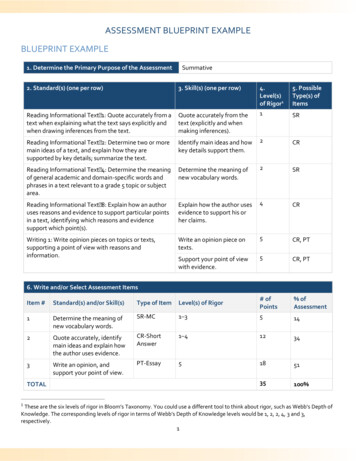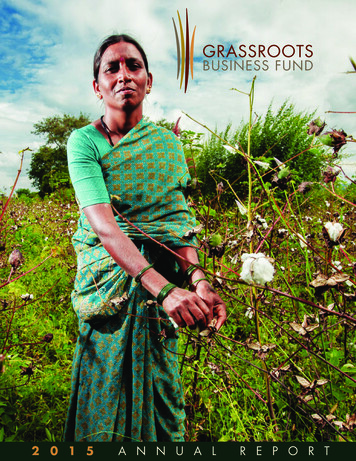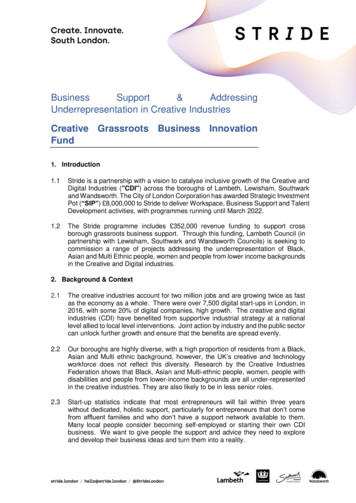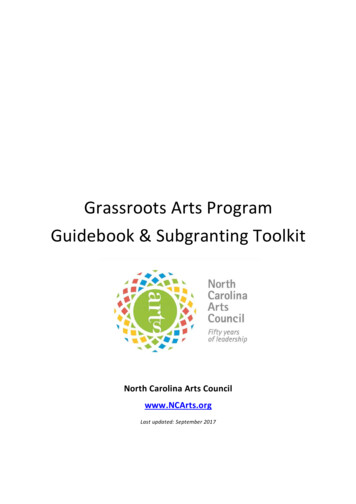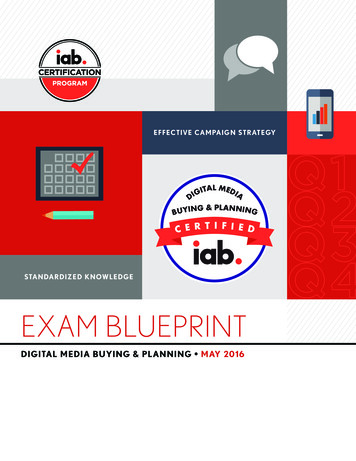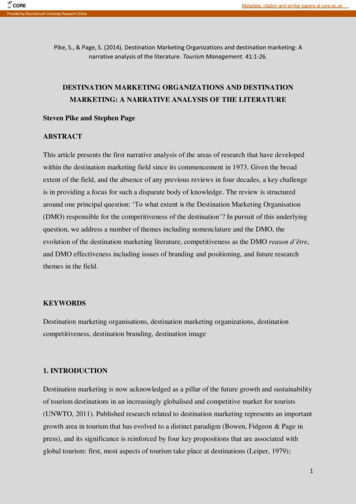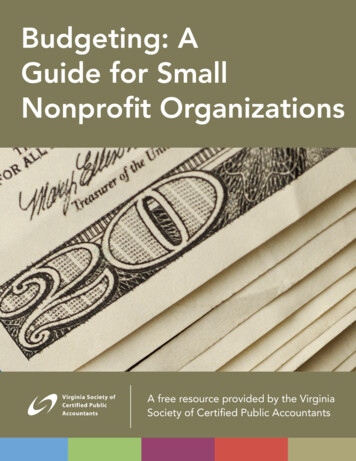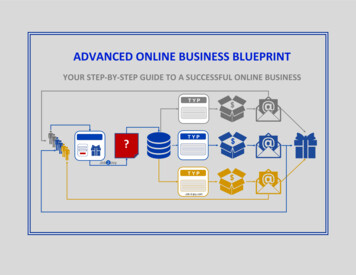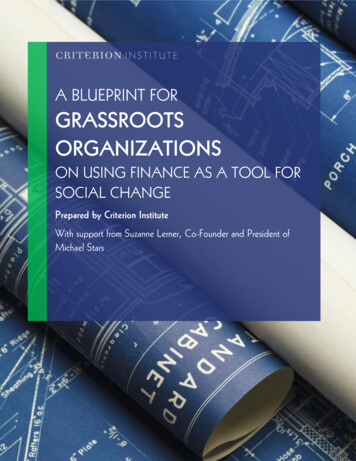
Transcription
A BLUEPRINT FORGRASSROOTSORGANIZATIONSON USING FINANCE AS A TOOL FORSOCIAL CHANGEPrepared by Criterion InstituteWith support from Suzanne Lerner, Co-Founder and President ofMichael StarsDRc1
TABLE OF CONTENTSPREFACE3BLUEPRINT: Framing8BUILDING MATERIALS: Assets15FLOOR PLANS: Strategy22DOORS: Starting Places38NEIGHBORHOOD: Finance for Social Change412
PREFACEImagine a set of leaders from grassroots organizations around a table. They’ve come togetherfrom around the world to learn from one another and develop collaborative solutions to themost pressing issues affecting their communities. One organization has experience drivingpublic awareness campaigns and generating global media coverage on the root causes and localimpact of income inequality and has influenced legislation at a local and national level as aresult. One has amazing research about women’s safety in communities that is used bypolicymakers and civil society to identify best practices and priorities for funding. One is acohort of indigenous groups who are developing and implementing native solutions to preserveagricultural land in the face of climate change.Now imagine that a group of leaders in the financial sector join them. One is an investmentadvisor who creates customized investment strategies for foundation endowments that alignclients’ financial goals with their social impact objectives. One manages a small private debtfund, issuing loans to social entrepreneurs with a high potential to revitalize communities. Theother is a data analyst for a large public equity fund, who has pioneered a framework for usingdata on social issues to evaluate investment risk in publicly traded companies.The table is set. How can this group mobilize their collective assets to contribute to a long-termsocial change strategy?The debt fund and the indigenous groups join forces to co-design a new fund structure tofinance smallholder farms practicing sustainable land-use practices. They mutually determinethe criteria they will use to identify and evaluate potential investees and decide that the fundwill issue low-interest loans with flexible payment schedules, recognizing that changing weatherpatterns are leading to less predictable crop seasons. They envision these loans will allow thefarmers to access equipment and technologies that will save time and increase productivity,helping them to grow their operations while continuing to protect the land, create new jobs,earn more sustainable income, and contribute to local communities’ access to healthy andaffordable food.Meanwhile, the research organization shows their data to the analyst at the public equity fund,who helps to translate it into language that speaks to finance professionals. Together they drawcorrelations between women’s safety and access to education and employment, factors thatsignificantly affect a community’s labor market. They create a set of guidelines for investors,outlining the risks of investing in companies that don’t consider the safety of their current andfuture workforce as well as the opportunities associated with investing in companies thatprotect and reinvest in the communities in which they operate. They create a list of best-inclass and worst-in-class companies, based on the research organization’s extensive interviewswith grassroots leaders around the world.The investment advisor is inspired and commits to integrating these guidelines and the newlydesigned fund for smallholder farmers into the investment strategies she is designing for herclients, driving more investment capital into the newly uncovered opportunities.3
The advocacy organization has a vision for larger-scale influence. They begin to design acampaign that engages the media, local businesses, government agencies, and other grassrootsorganizations to pressure investors to adapt the guidelines. The investment advisor is inspiredand offers to bring the campaign to the networks she is a part of that bring together assetholders and asset managers who are committed to investing for social change.The ideas keep flowing. Each of the participants at that table shares their knowledge aboutsocial change and systems of finance and together they create a comprehensive approach toleverage the power of financial systems to create safe and resilient communities. The strategyengages finance as a system of power that holds the key to new tools and trusted partnerships.The strategy incorporates the wisdom and assets of local communities with the knowledge andresources of investors, valuing what each actor brings to the table. The strategy focuses onshifting power in relationships within and around finance in a way that creates access for thosethat have not been at the table. This leads to the expansion and demonstration of newpossibilities to create long-term systems change using finance.The premise of this Blueprint is that this table would be an exciting place to be.These are just a few out of many ways that grassroots leaders could and, in some cases,already are using finance to create social change on a variety of issues. Throughout this guide,we will be illustrating other cases, covering issues such as access to affordable housing, incomeinequality, and indigenous land rights, to name just a few. This is a guide for organizations andindividuals actively seeking to create transformative social change, whatever their specific issuefocus. In particular, this guide enables them to design strategies that use systems of financeand private sector investment as tools to create positive social change.Grassroots organizations come in many shapes and sizes. For the purposes of this Blueprint, wehave focused broadly on local organizations that are developing solutions that are designed andled by impacted communities and driven by community demand. This includes a wide variety ofcommunity-based organizations, as well as indigenous tribes, local chapters of unions, religiouscongregations, networks or coalitions of grassroots organizations that are coordinating activitiesamong various community groups, campaigns started by local activists, and more. Theseorganizations, at their core, are inherently skilled at shifting traditional power norms away from“trickle-down” solutions toward new models and practices that value the knowledge and agencyof local communities.As grassroots organizations continue to transform relationships of power to expand whosevoices are heard, they need to deploy all strategies at their disposal to create the social changethey seek. Finance is one strategy, along with community organizing, advocacy, research, andmedia campaigns. The programmatic work grassroots organizations are carrying out can besupported, for example, by leveraging new allies within the financial communities that arealready thinking about doing things in new and different ways. While using systems of financefor social change may be a new area of work, the barrier to entry may not be as high asanticipated and can build on the networks, power, skills, and experience that grassrootsorganizations already have at their disposal.Furthermore, grassroots organizations who uncover opportunities to use finance to createtransformative social change do not need to work alone or take on everything by themselves inorder to implement a new project or vision. Rather they can align their strategy with their4
existing skills and strengths, while identifying new collaborators who can help shape ideas,bring in new allies, and carry the work forward in partnership.ACKNOWLEDGEMENTSThis Blueprint is one in a series of guidebooks developed to help social change makersdemystify finance and help change makers such as grassroots organizations see themselves ashaving the power to engage with and influence financial systems. We want to share theknowledge we have gained with others who can influence this complex system of power inways that create the changes we seek. This Blueprint follows the 2017 publication of ABlueprint for Women’s Funds on Using Finance for Social Change, developed in partnership withthe Global Fund for Women and Ms. Foundation, and the 2018 publication of A Blueprint forINGOs on Using Finance for Social Change, developed in partnership with Oxfam America.A Blueprint for Grassroots Organizations on Using Finance for Social Change was supported bySuzanne Lerner, Co-Founder and President of Michael Stars. Criterion Institute’s ChristinaMadden led the production of the publication, with contributions from Amy Chen, Lori Holmes,Ashante Little, and Tia Subramanian. While it has been edited and adapted specifically forgrassroots organizations, the publication’s framework and portions of the text are largely basedon prior editions. As such, we would like to acknowledge Oxfam America’s Mara Bolis, as herco-authorship of A Blueprint for INGOs on Using Finance for Social Change greatly contributedto shaping this Blueprint.Throughout the course of developing the publication, Criterion Institute engaged dozens ofgrassroots organizations through one-on-one interviews, group conversations, eventsattendance, and desk research to identify existing models and ideas that grassrootsorganizations are already employing or exploring for using finance as a tool for social change.We especially want to acknowledge the input of Emily Bove and members of the GrassrootsAffinity Group she led at Opportunity Collaboration; Lindley Mease of Thousand Currents whointroduced us to the Buen Vivir Fund and diverse grassroots leaders; and the numerousorganizations grounded in local communities that have shared their stories and are leadingtransformational change.WHY GRASSROOTS ORGANIZATIONS?The ecosystem and incentives driving decision making within financial institutions andgrassroots organizations are often vastly different, so why would grassroots organizationsengage finance as a tool for social change? Social return and financial return often seem atodds, the language of finance is complex, and relationships with those in finance are not alwayseasy to access. Furthermore, systems of finance have in some cases had extractive andexploitive impact on communities.So why grassroots organizations? Systems of finance hold a lot of power that could beleveraged to create just and equitable change and grassroots organizations have many toolsalready at their disposal to compel finance to do so.5
Grassroots organizations, because of their closeness to communities, have the ability to see theharm and inequities that are caused or perpetuated by current structures, policies andsystems—including finance—and how that impacts their communities. They understand powerdynamics and work to transform who has access to power and whose voices are valued indecision-making processes.Many grassroots organizations have experience raising public awareness about the issuesimpacting their local communities. They are also able to see the interconnectedness of a varietyof issues—such as the linkages between climate change, equitable access to resources, andpeace and stability of regions—correlations that may be meaningful to (yet very oftenoverlooked by) financial actors.They possess an ability to bring communities together, drawing on their collective power andknowledge, to challenge and disrupt harmful realities and to create new possibilities. They areable to think outside of what currently exists to develop new models and find new solutions toeffect impactful and sustainable change, solutions that are grounded in community expertiseand agency.These skills translate to finance in a number of ways, from being able to influence or disruptcurrent models of finance that may be extractive or exploitative, to forging alliances with peoplewithin finance who share common social change objectives, to devising and implementing neweconomic and financial models that meet the needs of local communities.Although grassroots organizations are our key audience, we see the lessons in the Blueprint ashighly relevant for a wide array of organizations and individuals, such as the philanthropiccommunity, corporations, and donor agencies.In addition, investment professionals can make use of this Blueprint to think through how toeffectively collaborate with grassroots organizations and other change-making organizations.WHY A BLUEPRINT?This Blueprint facilitates the imagination and design of a future that is more equitable,representative, and just through the increased participation of grassroots organizations inpowerful systems of finance. This Blueprint lays out the strategies that can serve as templates,but intentionally leaves room for contextualization, exploration, and innovation in design.The Blueprint is a useful tool for those designing and building strategies for social change. Inthe rest of the document, we answer: What opportunities exist for grassroots organizations to engage finance and use it as atool for social change? What are the materials or assets held by grassroots organizations that can be leveragedto influence finance? How do those materials or assets come together around a specific strategy in detailedimplementation activities?6
How do the strategies fit together to accomplish complex social change agendas? Weexplore a variety of social change issues, including indigenous land rights, resourceextraction, gender-based violence, climate resilience, and new community-driveneconomic models. What would a broader field of collaborative activity look like, with multiple organizationsand sectors working together in a coordinated effort to leverage the power of financetowards collective impact on social issues? What power can grassroots organizations realize and leverage to use finance to createthe social change they seek?AN INVITATIONWhat are our hopes, dreams, and next steps? This Blueprint is the beginning of a conversationwith organizations working towards social change that critically examines power dynamics inthe financial community and thinks imaginatively about using finance as a tool to achieve socialchange goals. In addition, it is a conversation that involves listening, learning from each other,and sharing our stories.We look forward to a rich and fruitful dialogue over time, and we invite you to share yourstories with us as you explore and experiment with new possibilities to use finance as a tool inyour efforts to change the world.7
BLUEPRINT:FramingFramingAssetsDR8
FRAMINGThe focus of the Blueprint is to show how individuals working within grassroots organizationscan use finance as a tool in their work, whether by disrupting or influencing current systems,forging new alliances or partnerships with individuals and organizations that are already usingfinance for social change, or by crafting new models that fundamentally shift how poweroperates in the economic and financial relationships within a community.The Blueprint does not assume expertise in finance or investment but recognizes that shapingfinancial systems is not on the agenda of many grassroots organizations. Rather, the Blueprintassumes that the reader has experience engaging, challenging, and shifting systems of power,experience that can be applied to financial systems.It is important to remember that “finance” and “capitalism” are not synonymous. Capitalism is apolitical and economic theory about financial ownership and decision-making. Finance is asystem of managing money—be it personal, organizational, or government money—which mayinclude, among other activities, investing in stocks or bonds, lending or borrowing money withor without interest, investing capital in an organization in exchange for a percentage ofownership in the organization, or saving money in an account that earns interest.It is an incredibly powerful system, one that determines who can buy a home or start or grow anew business, who can access emergency funds in a crisis, what products, services, andbusiness practices are able to scale, and more—decisions that have enormous consequences onour communities. It is important to remember, however, that it is also a system that operatesaccording to the same rules of power as any other system. Finance is a set of relationshipsbetween people and organizations with various goals related to money trying to meet thosegoals with the best information they have.Investors have many goals for their money, and finance is not necessarily about profitmaximization. Nonetheless, finance can feel like an incredibly closed off system, riddled witharcane terminology and complex processes with built-in biases. Often the people andorganizations who could benefit most from finance are the very ones who have the mostdifficulty accessing it.But it doesn’t have to be this way.This Blueprint is a document about social change, written for change makers, to guide them inseeing and exercising the power they have to influence financial systems and create models forusing finance to benefit their communities and their social change agendas. Our hope is it canbe used to spur ideas for new programming and new collaborations, and also to advocateinternally within organizations and with external partners and stakeholders for greater attentionto the role of finance in advocating for transformative social change.We use the term “Blueprint” as a metaphor for the technical process of developing a detailedplan or program of action. The focus is on plans, rather than on case studies. The Blueprintpresents a framework that expands the imagination of leaders in a specific context, so they canmove from design to implementation.9
The Field of Finance for Social ChangeUsing finance for social change can mean many things—whether it is influencing so-called“traditional” finance or engaging in the growing field of so-called “social” finance. The formerapproach may mean influencing traditional or mainstream capitalist systems by uncovering andamplifying the financial relevance of social issues, such as how they may correlate toinvestment risks or opportunities. For instance, corporations’ environmental, social, andgovernance practices (popularly referred to in finance as “ESG”) are garnering greater andgreater scrutiny as data about company behavior and consequences becomes more widelyaccessible. One approach to influencing traditional finance may involve making investors morebroadly aware of the potential for corporations who don’t take ESG seriously to suffer financiallosses or fail to adapt. These investors may decide that corporations which don’t, for example,have clean energy practices or a diverse board are at risk for worse performance, and thereforescreen out those corporations from a portfolio. ESG data is increasingly being used by mutualfunds, pension funds, and other mainstream institutional investors.Many investors and finance professionals are already using their investments or access tocapital for the explicit purpose of achieving social impact or a combination of social impact andfinancial return. These investors may, for instance, use the above-mentioned ESG criteria notonly to measure risk to their investment portfolios but also to evaluate the potential positiveand negative impacts of their investments before deciding whether or not to invest in particularcompanies. There are many labels and movements within this field —impact investing,microfinance, sustainable finance, and socially responsible investing, to name just a few—all ofwhich share a common goal: to rethink the purpose of capital to be not solely about profitmaking but also to transform relationships of power for more just and sustainable outcomes forsociety.Finance for social change can be—and increasingly is—applied at a community level. This hasled to an emergence of economic and financial models that are being developed and led bygrassroots organizations, independent from—and not reliant upon—traditional capital marketsor mainstream financial systems. While some are new and innov
the Global Fund for Women and Ms. Foundation, and the 2018 publication of A Blueprint for INGOs on Using Finance for Social Change, developed in partnership with Oxfam America. A Blueprint for Grassroots Organizations on Using Finance for Social Change was supported by S
